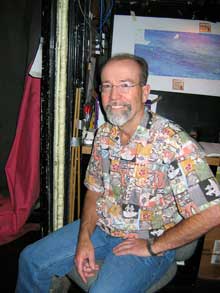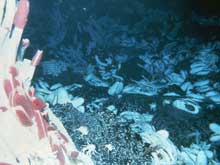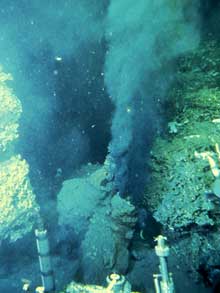
Ken Macdonald in the JASON control van aboard R/V Thompson, Dec 2005. Click image for larger view and image credit.
A Career at Sea:
38 Years of Exploring the Oceans
January 1, 2006
Ken Macdonald
Professor Marine Geophysics and Tectonics
I have been going to sea for 38 years. I was 20 years old my first time, sailing as an ordinary Seaman on the R/V Virginia City. After getting my PhD in Marine Geophysics in 1975, I sailed as a scientist and started my career exploring the global mid-ocean ridge system of volcanoes. The exploration of mid-ocean ridges has become even more fun over time with the development of new tools including the remotely operated vehicles we are using on this expedition. The video, still photos, side-scan sonar images and maps reveal so much more information and detail than the primitive camera sleds and echo-sounders we used years ago.
I have been on over 30 expeditions, one of my first being to the Galapagos in 1972 when I was a graduate student at Woods Hole Oceanographic Institution/MIT. I was invited to go on one of the ships operated by the Scripps Institution of Oceanography and my mission was to measure earthquakes on the Galapagos Spreading Center. Earthquake sensors around the world showed that there was a very long stretch along the eastern Galapagos spreading center that had no earthquakes- very strange since it is a very active mid-ocean ridge. Why were there no earthquakes?
I flew down to Ecuador to catch the ship and brought a dozen sonobuoys with me that were surplus from the US Navy (sonobuoys have an underwater microphone or “hydrophone” and transmit underwater sounds back to the ship by radio). The Navy uses them to track enemy submarines, but I figured they would work well to detect earthquakes too, and I could get them for free. I launched several sonobuoys as soon as we arrived on station, and right away they were picking up lots of earthquakes that sounded like cannons going off. Sometimes there were 80 earthquakes in just one hour!
The spreading center was very active with many small earthquakes but almost no big earthquakes, which is why the land stations could not detect them. I located the earthquakes and we steamed to their area. We found an amazing thing- hundreds of dead and dying Rattail fish floating on the surface. These fish usually live at great depth near the seafloor, about 8,000 feet below us. Somehow the swarm of earthquakes I measured had killed these fish, but how? We thought there might have been a volcanic eruption or a big burst from a hotspring. If only we had the instruments we have now, we could have seen the source of this strange fish kill. Five years later ALVIN dove on this exact site and this is where the first deepsea hydrothermal vents were discovered with huge tube worms and other exotic animals that live off the energy of volcanoes. A coincidence? I don’t think so. A major event at these hotsprings probably killed the fish we saw five years earlier.
So now I am back at the Galapagos 24 years later after spending a career exploring the Mid-Atlantic Ridge, the East Pacific Rise and the Red Sea; a total of three years of my life at sea. I was co-chief scientist on the 1979 RISE expedition where the first superheated “black smoker” hydrothermal vents were found on the East Pacific Rise off the Mexican coast. This was one of the most thrilling experiences in my life: stumbling upon a whole field of chimneys belching out black “smoke” like a row of smoke stacks at a steel mill. The blackened water, laden with mineral particles, was shooting out so fast it looked like a fire hydrant that had been opened up full blast. The superheated water was 380ºC, hotter than a pizza oven, and hot enough to melt the portholes of the the submersible, ALVIN, if we stayed too long. And now, in December 2005, we have discovered the first black smoker vents on the Galapagos Spreading Center along with many other warm springs. The exploration continues, and it’s great to be back here.
GalAPAGoS: Where Ridge Meets Hotspot will be sending reports from Dec 3 - Jan 10. Please check back frequently for additional logs from this expedition.
Sign up for the Ocean Explorer E-mail Update List.






























